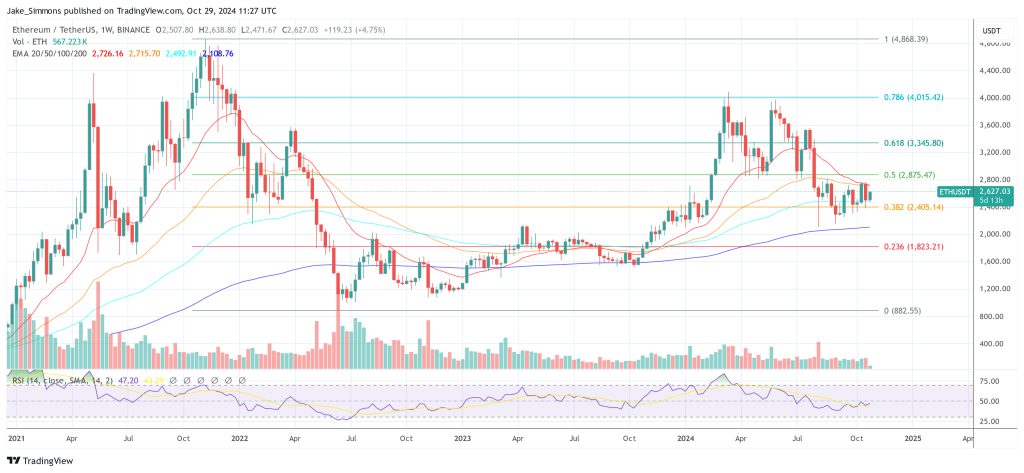Ethereum co-founder Vitalik Buterin announced “The Splurge,” a comprehensive set of protocol upgrades aimed at addressing various challenges within the Ethereum ecosystem. In his latest blog post titled “Future Possibilities for the Ethereum Protocol, Part 6: Splurge,” Buterin describes the technology for upcoming enhancements that will push Ethereum toward a more performant, secure, and scalable future. delving into the complexities of
“The Splurge” is designed to address a collection of “little things” in Ethereum protocol design that don’t fit neatly into existing upgrade categories. According to Buterin, these elements are “invaluable to Ethereum's success” but must be dedicated to because of their complexity and importance.
What is an Ethereum “splurge”?
The Splurge's main goals include bringing the Ethereum Virtual Machine (EVM) to a more performant and stable “endgame state” and integrating account abstraction directly into the protocol to improve security and user experience. This includes reducing risks while increasing scalability and optimizing transaction fee economics. , and is exploring cutting-edge cryptographic techniques to significantly improve Ethereum over the long term.
Buterin emphasized the need to improve EVM, saying, “Today's EVMs are difficult to statically analyze, making it difficult to create highly efficient implementations, formally verify the code, and make further enhancements over time.” “It's becoming difficult.” The introduction of EVM Object Format (EOF) is the first step in the EVM improvement roadmap and will be included in the next hard fork. EOF introduces features such as separating code and data, disallowing dynamic jumps in favor of static jumps, removing gas observability in EVM code, and adding an explicit subroutine mechanism.
EOF lays the foundation for further upgrades, including the integration of EVM modular math extensions (EVM-MAX) and single instruction multiple data (SIMD) capabilities. These enhancements are aimed at making EVM more efficient for advanced cryptographic operations without relying heavily on precompilation. “After implementing EOF, it will be easier to implement further upgrades,” Buterin said.
Account abstraction has been a long-standing goal of Ethereum, with the goal of allowing smart contract code to control transaction validation. “Essentially, the account abstraction is simple: we allow transactions to be initiated by smart contracts, not just EOAs,” Buterin explains. This feature could potentially enable a variety of applications, from quantum-resistant cryptography to seamless key rotation to improved wallet security.
ERC-4337 serves as the current solution for implementing account abstraction without changing the core protocol. A new object called “User Operation” is introduced to separate transaction processing into validation and execution phases. But Buterin points out the inefficiencies of this approach, particularly the “gas overhead of almost 100,000 per bundle.”
EIP-7702 is proposed to bring the convenience benefits of account abstraction to all users, including externally owned accounts (EOA), by integrating account abstraction directly into the protocol. This move could unify the ecosystem and eliminate the need for relayers in privacy protocols. “With EIP-7702, the ‘nice feature’ of account abstraction is now available to all users, including EOAs,” Buterin wrote.
Although EIP-1559 has improved the predictability of average block inclusion times and fees, Buterin acknowledges that there are imperfections in its implementation. “There are some flaws in this formula,” he said, “and it doesn't adjust fast enough in extreme situations.” Proposed EIP-7706 addresses these issues by introducing multidimensional gas pricing, with separate prices for different resources such as call data, state read/write, and state size expansion. It is intended to allow settings and restrictions.
“Multidimensional gas has two main tradeoffs: It complicates the protocol and the optimal algorithm needed to fill blocks to capacity,” Buterin explains. However, he suggests that the benefits in efficiency and resource management may outweigh these complexities.
The introduction of Verifiable Delay Functions (VDF) aims to improve the randomness of Ethereum's proposer selection process. “Ideally, we would like to find a more robust source of randomness,” Buterin said. VDFs can potentially provide a solution that reduces the likelihood of manipulation by providing an output that is computationally intensive to produce but easy to verify. Issues such as “unexpected optimization” due to hardware acceleration and parallelization remain. “Currently, there is no VDF construction that completely satisfies Ethereum researchers in all aspects,” Buterin acknowledged, suggesting that further research and development is needed.
Additionally, Buterin explores the “far future of cryptography” by discussing advanced concepts such as non-identifiable obfuscation and one-shot signatures. He calls them part of the “Egyptian God Protocol,” an extremely powerful cryptographic primitive that could revolutionize blockchain technology. Indiscernible obfuscation allows the creation of “encrypted programs” that perform arbitrary calculations while keeping their internal details hidden. “By combining obfuscation and one-shot signing, you can create a nearly perfect trustless third party,” Buterin argues.
Potential applications include secure DAOs and auctions, universally trusted setups, simplified verification of zero-knowledge proofs, and more. Despite their promise, these technologies are still in their infancy. “There's still a lot of work left to do,” Buterin admits. Currently, implementations of indistinguishability obfuscation face significant performance hurdles, and practical quantum computers that enable one-shot signatures are still in the theoretical stage.
Buterin aims to keep Ethereum at the forefront of blockchain innovation by working on improving EVM, abstracting accounts, optimizing transaction fees, and exploring the frontiers of cryptography. While he acknowledges the complexities and tradeoffs involved, he remains optimistic. “Very strong encryption could completely change the game,” he concludes.
At the time of writing, ETH was trading at $2,627.

Featured image created with DALL.E, chart on TradingView.com

